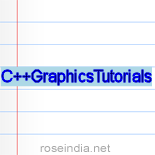C++ Graphics Tutorials
- Game programming with DirectX
This document and all files and code provided with it are provided "as is" and without any warranty at all, not even the implied warranty of fitness of use for any particular purpose. I am not responsible for any harm that might come from use or misuse of either this document or any of the files available for download from this site. Neither is there any guarantee that the information in this document is correct. C/C++ Windows programmers who want to learn to write applications that use Microsoft's confusing API, DirectX. There is some MFC stuff in here, but mostly I am trying to get rid of it. You don't need to know MFC.
- OpenIL in Dev-C++
OpenIL is an open source source code level library for loading and saving various image types. It has syntax similar to OpenGL and using OpenIL's ILUT interface can be used directly with OpenGL. Similar to the other Open_ libraries, OpenIL is supposed to be platform independent and free. It is both, but it only really works with Microsoft's horribly expensive Visual C++ without a lot of work. I'm sure the Free Software Foundation people would frown on this =). Here comes Deraj to the rescue! I've gone through all the trouble and broken links to get OpenIL working under Windows and the FREE Dev-C++ IDE/compiler! This probably wouldn't be too much trouble for a seasoned veteran, but I'm not one of those and this took a lot of tinkering to finally get working.
- DirectX 8 Tutorials
Welcome to my DirectX tutorials. This is the first in a number of tutorials that should at least help you on the way to make Windows games using Microsoft DirectX 8. I have decided to write these tutorials for two reasons. Firstly, I?m a complete beginner when it comes to DirectX. So, the idea is that as I learn, I can write a short tutorial that should reinforce my knowledge. Secondly, the SDK isn?t the most helpful thing in the world for complete beginners starting out in game development. Also, there isn?t a great deal of stuff out there on the Internet for beginners and DirectX 8, so this should help.
- NeHe Productions
The lessons on this page may contain mistakes, poor commenting, and should not be considered the best resource to learn OpenGL from. What you do with the code is up to you. I am merely trying to make the learning process a little easier for those people new to OpenGL. If you are serious about learning OpenGL, you should spend the money and invest in the following books: Red Book Version 1.4 (4th ed.): 0321173481, Blue Book Version 1.4 (4th ed.): 032117383X, Orange Book Version 1.4 (Shading Language): 0321197895. Although they can be difficult for the new OpenGL programmer to understand, they are by far the best books written on the subject of OpenGL. Another book I would recommend is the OpenGL Superbible, although opinions vary. It is also important that you have a solid understanding of the language you plan to use. Although I do comment the non-GL lines, I am self-taught, and may not always write proper or even good code.
- The
X-Zone
Provides an introduction to the dot product function, which determines the relationship of two vectors, and explores various uses of this function . Provides a look at the the mathematical and practical differences between Z and W based depth buffering. Includes code to detect W-Buffering hardware and implement W based depth buffers. The first in a series of articles targetted at DirectX Effect Files, provides an introduction to the use of Effect Files with the D3DX framework. Effects allow the developer to define rendering techniques outside of application code. Benefits include greater flexibility for your rendering engine, support of various hardware capabilities, and a rapid integration of new objects and visual effects into an application without the need for changes to compiled code.
- DirectX Graphics C/C++ Tutorials
The tutorials in this section show how to use Microsoft® Direct3D® and Direct3DX in a C/C++ application for common tasks. The tasks are divided into required steps. In some cases, steps are organized into substeps for clarity.To use Microsoft® Direct3D®, you first create an application window, then you create and initialize Direct3D objects. You use the COM interfaces that these objects implement to manipulate them and to create other objects required to render a scene. The CreateDevice sample project on which this tutorial is based illustrates these tasks by creating a Direct3D device and rendering a blue screen.
- OpenGL Developer Documentation
OpenGL is the industry's most widely used, supported and best documented 2D/3D graphics API making it inexpensive & easy to obtain information on implementing OpenGL in hardware and software. There are numerous books, tutorials, online coding examples, coding seminars, and classes that document the API, Extensions, Utility Libraries, and Platform Specific Implementations. The OpenGL Programming Guide, now in its third edition, is the definitive volume for programmers using this evolving graphics interface standard. Written by members of the OpenGL Architecture Review Board, this book offers understandable tutorials and lessons on getting up to speed and getting the most out of the latest version of OpenGL, version 1.2.
- Basic Graphics Programming With The Xlib Library
This tutorial is the first in a series of "would-be" tutorials about graphical programming in the X window environment. By itself, it is useless. A real X programmer usually uses a much higher level of abstraction, such as using Motif (or its free version, lesstiff), GTK, QT and similar libraries. However, we need to start somewhere. More than this, knowing how things work down below is never a bad idea. After reading this tutorial, one would be able to write very simple graphical programs, but not programs with a descent user interface. For such programs, one of the previously mentioned libraries would be used.
